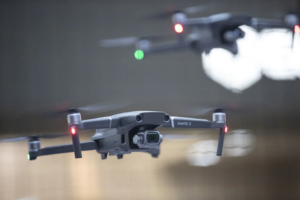 Unmanned aerial vehicles (UAVs) or drones, essentially robotic aircraft, have proliferated in many applications over the last few years, including agriculture. Development of ground-based robots for agricultural applications is also on the rise. The Cotton Engineering program has been conducting research in both UAVs and ground-based robots for cotton-specific applications.
Unmanned aerial vehicles (UAVs) or drones, essentially robotic aircraft, have proliferated in many applications over the last few years, including agriculture. Development of ground-based robots for agricultural applications is also on the rise. The Cotton Engineering program has been conducting research in both UAVs and ground-based robots for cotton-specific applications.
Projects:
-
Field-based Detection and Removal of Plastic Contamination of Cotton
Any non-cotton material in a bale of cotton fiber is undesirable, and some contaminants like plastics can cause major problems when spun into yarn along with cotton fiber. One point at which plastic contaminants can enter cotton is during harvest, when various types of plastic like shopping bags may be present in a farm field, and pieces are inadvertently ingested into the harvester along with the seed cotton. Therefore, the Cotton Engineering program has been conducting research to determine whether plastic shopping bags that may blow into a cotton field can be detected and potentially removed by a UAV flying over the field with a camera.
-
Enhancing Accuracy and Reliability of Image Data from UAV Remote Sensing
Images that are captured with UAVs can potentially be used to make decisions about when and where to apply irrigation water, defoliant, pesticide, etc. It is critical that these images contain information that is consistently accurate and trustworthy. The Cotton Engineering program has been conducting research on methods to calibrate UAV image data, and the accuracy of the data has been vastly improved with the methods developed in this project. The methods involve not only UAVs but also ground-based robots that position themselves under the UAV during image collection serve as references for calibrating the data.
-
Detection, Identification, and Mitigation of Feral Cotton Plants
Volunteer or “feral” cotton plants are those that were not planted as part of a crop in normal farm operations. These plants can result from seeds left (1) in the field from a prior growing season, in which case cotton plants may grow up in a corn field, for example; (2) in areas where seed cotton modules were stored; and (3) along roadsides where modules are transported from the field to the gin and seed cotton blows off the truck. These plants can present a growth habitat for destructive insects like the cotton boll weevil, so it is important to either destroy them or treat them. The Cotton Engineering program has been conducting research to determine whether feral cotton plants can be detected by a UAV flying over the field or roadside with a camera.
-
Robotic Harvesting
Cotton harvesting in the U.S. is done with very large and expensive machines. These machines are highly efficient, but their use requires once-over harvesting that does not allow for optimization of the quality of the cotton. Cotton bolls start opening up early in the season, exposing the fiber to weathering and quality degradation for many weeks until the final harvest. Periodic harvesting would enable cotton bolls to be harvested soon after opening, maximizing the quality of the fiber. Furthermore, the large harvesting machines are very heavy and have the potential to cause problems with soil compaction in the field. For these and other reasons the use of small robotic harvesting machines that could harvest open cotton bolls multiple times in a growing season has potential advantages. The Cotton Engineering program has been conducting research on robot “end-effectors” that would enable a small robot to pick seed cotton from an open boll without any human involvement.
-
Robotics and Biophotonics Enabled Plant Phenotyping
Plant breeders conduct research to find crop plants that have higher yield, are resistant to pests, are drought-resistant, or have other desirable characteristics. They grow numerous plots of various genetic varieties of and record data on important parameters of the plants so they can make decisions about which genotypes to select for future study and development. Collecting data on these parameters is called phenotyping, and modern methods of “high-throughput phenotyping” (HTP) incorporate robotic platforms that carry sensors to collect the data. The Cotton Engineering program is conducting research on combinations of sensors and robotic platforms for HTP in order to provide cotton breeders new tools for crop improvement.